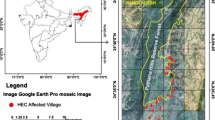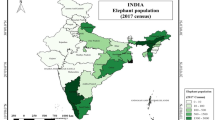Abstract
An attempt has been made to analyze the temporal and spatial patterns of human-elephant conflict (HEC) and mitigation measures adopted in West Bengal, a thickly populated and agrarian state of India. West Bengal supports only 2% elephant population of India but contributes to the highest human casualties due to HEC. A total of 726 human deaths, 1233 human injuries, 51,542.027 ha areas of crop loss, 34,446 hut damage, and 136 unnatural elephant deaths were reported in West Bengal during April 2010 to March 2019 due to direct HEC. Electrocution was the leading cause of unnatural elephant deaths, followed by train accidents and poaching. South Bengal witnessed maximum crop raiding by elephants. About INR 59.09 crores were compensated by the government to the victims of wild elephant depredation during the same period. Both human and elephant population is increasing and resulting in higher HEC. Natural elephant habitats become fragmented and even degraded due to rapid urbanization and human intervention. Increasing HECs not only cause a negative impact on the agro-based and forest-based household economy of rural people living in conflict prone areas of almost thirteen districts of the state, but also pose a major threat to elephant conservation. Apart from traditional short-term elephant driving practices, several long-term cost-effective and innovative mitigation measures should also be taken involving local communities and other stakeholders for proper management of natural elephant habitat, restoration of elephant corridors, protection of elephants, reduction of HEC, and sustainable development in the state of West Bengal.









Similar content being viewed by others
References
Barua P, Bist SS (1995) Changing pattern in the distribution and movement of wild elephants in Northern Bengal. In: Daniel JC, Datye HS (eds) A week with elephants. Bombay Natural History Society, Oxford University Press, Bombay, pp 66–83
Bhaduri T (2019) North Bengal: the new arena of man-elephant conflict in India. EastMojo. https://www.eastmojo.com/news/2019/11/29/north-bengal-the-new-arena-of-man-elephant-conflict-in-india/. Accessed 21 Aug 2021
Bist SS (2006) Elephant Conservation in India-an Overview Gajah 25:27–37
Chakraborty K, Mondal J (2013) Perceptions and patterns of human–elephant conflict at Barjora block of Bankura district in West Bengal, India: insights for mitigation and management. Environ Dev Sustain 15:547–565. https://doi.org/10.1007/s10668-012-9392-2
Chakraborty S, Paul N (2021) Efficacy of different human-elephant conflict prevention and mitigation techniques practiced in West Bengal, India. Not Sci Biol 13(3):11017. https://doi.org/10.15835/nsb13311017
Choudhury A (2004) Human–elephant conflicts in Northeast India. Hum Dimens Wildl 9(4):261–270. https://doi.org/10.1080/10871200490505693
Das Chatterjee N, Mandal N (2020) Human-elephant conflict in Panchet Forest Division, Bankura, West Bengal, India. Gajah 51:10–15
Das Chatterjee N (2016) Man-elephant conflict. a case study from forests in West Bengal, India. Springer Briefs in Environmental Science, Springer International Publishing, Switzerland. https://link.springer.com/book/10.1007/978-3-319-31162-3
Dasgupta S, Ghosh AK (2015) Elephant–railway conflict in a biodiversity hotspot: determinants and perceptions of the conflict in Northern West Bengal. India Hum Dimens Wildl 20(1):81–94. https://doi.org/10.1080/10871209.2014.937017
Easa PS (2017) Asian elephants in India: a review. In: Right of passage: elephant corridors of India, 2nd edn. Menon V, Tiwari SK, Ramkumar K, Kyarong S, Ganguly U Sukumar R (eds) Conservation Reference Series No. 3. WIldlife Trust of India, New Delhi
Gupta A (2017) Giving elephants the space they need, one SMS at a time. The Wire https://thewire.in/environment/elephants-bengal-deaths-kerala-drought. Accessed 21 Aug 2021
Gomez KA, Gomez AA (1984) Statistical procedures for agricultural research, 2nd edn. John Wiley and Sons, New York, USA, p 680
Government of West Bengal (2002) Elephant reserves: Mayurjharna. Directorate of Forests, Government of West Bengal. http://www.wildbengal.com/mayurjharna.php. Accessed 17 Aug 2021
Government of West Bengal (2014a) Training manual for elephant census 2014 in North Bengal (2014). Conservator of Forests, Wildlife North Circle. Wildlife Wing, Government of West Bengal
Government of West Bengal (2014b) Annual Report (2013–14). Wildlife Wing, Directorate of Forests. Government of West Bengal http://www.wildbengal.com/admin_wildlife/upload/3383Wildlife%20Annual%20Report%2013-14.pdf. Accessed 17 Aug 2021
Government of West Bengal (2015a) Database on environment and forestry statistics of West Bengal (2015). Bureau of Applied Economics and Statistics, Department of Statistics and Programme Implementation, Government of West Bengal. http://www.wbpspm.gov.in/publications/Others. Accessed 17 Aug 2021
Government of West Bengal (2015b) Annual report (2014–15). Wildlife Wing, Directorate of Forests. Government of West Bengal. http://www.wildbengal.com/admin_wildlife/upload/7811Wildlife%20Annual%20Report%2014-15(2).pdf. Accessed 17 Aug 2021
Government of West Bengal (2016) Annual report (2015–16). Wildlife Wing, Directorate of Forests. Government of West Bengal. http://www.wildbengal.com/admin_wildlife/upload/5453Wildlife%20Annual%20Report%2015-16.pdf. Accessed 17 Aug 2021
Government of West Bengal (2017) Annual report (2016–17). Wildlife Wing, Directorate of Forests. Government of West Bengal. http://www.wildbengal.com/admin_wildlife/upload/9848ar-16-17.pdf. Accessed 17 Aug 2021
Government of West Bengal (2018) Annual report (2017–18). Wildlife Wing, Directorate of Forests. Government of West Bengal. http://www.wildbengal.com/admin_wildlife/upload/3286Annual_Report%202017-18.pdf. Accessed 17 Aug 2021
Government of West Bengal (2019) Annual report (2018–19). Wildlife Wing, Directorate of Forests. Government of West Bengal. http://www.wildbengal.com/admin_wildlife/upload/7427annual_report-18-19.pdf. Accessed 17 Aug 2021
Government of West Bengal (2021) Agriculture. Department of Agriculture, Government of West Bengal. https://wb.gov.in/departments-details.aspx?id=D170907140022669&page=Agriculture. Accessed 18 Jan 2021
Indian Chamber of Commerce (2022) State: West Bengal. Indian chamber of commerce, India. https://www.indianchamber.org/state/west-bengal. Accessed 18 Apr 2022
IUCN (2021) The IUCN red list of threatened species. Version 2021–3. ISSN 2307–8235 Available: https://www.iucnredlist.org. Accessed 21 Aug 2021
Kumara NH, Azeez PA, Singh A, Pal A (2018) Ecology of elephant (Elephas maximus) in South-West Bengal including population dynamics, migratory pattern, feeding habits and human-elephant conflict. Annual Report (April 2017-March 2018). Sálim Ali Centre for Ornithology and Natural History, Tamil Nadu
Lahiri-Choudhury DK (1975) Report on elephant movement and depredation in Jalpaiguri division and part of Madarihat range of Cooch Behar division in June–July, 1975. Report submitted to the West Bengal Government
Loiwal M (2016) Meanwhile in Midnapore, the battle between man and elephant rages on. India Today https://www.indiatoday.in/msn-itt/story/west-bengal-wild-elephants-stray-into-midnapore-destroy-crops-303093-2016-01-10. Accessed 21 Aug 2021
Mandal M, Das Chatterjee N (2020) Elephant’s habitat suitability assessment through geo spatial quantification in Panchet forest division. West Bengal EFCC 1(3):127–140. https://doi.org/10.1108/EFCC-05-2020-0012
Menon V, Tiwari SK (2017) Elephant corridors of India: an analysis. In: Right of passage: elephant corridors of India, 2nd edn. In: Menon V, Tiwari SK, Ramkumar K, Kyarong S, Ganguly U Sukumar R (eds) Conservation Reference Series No. 3. WIldlife Trust of India, New Delhi
Mitra S (2017) Elephant mortality on railway tracks of Northern West Bengal, India. Gajah 46:28–31
MoEF and CC (2010) MOEF to declare elephant as national heritage animal. Press Information Bureau, Government of India, Ministry of Environment, Forest and Climate Change. https://pib.gov.in/newsite/PrintRelease.aspx?relid=65467. Accessed 21 Aug 2021
MoEF and CC (2017) Synchronized elephant population estimation: India 2017. Project Elephant Division, Ministry of Environment, Forest and Climate Change, Government of India. http://www.indiaenvironmentportal.org.in/files/file/Synchronized%20Elephant%20Population%20Estimation%20India%202017.pdf. Accessed 21 Aug 2021
MoEF and CC (2018) Government of India Ministry of Environment, Forest and Climate Change. New Delhi-110003. Indira Paryavaran Bhavan: MoEF
MoEF and CC (2020) Government of India Ministry of Environment, Forest and Climate Change. New Delhi-110003. Indira Paryavaran Bhavan: MoEF. http://164.100.47.194/Loksabha/Questions/qsearch15.aspx?lsno=15
Naha D, Sathyakumar S, Dash S, Chettri A, Rawat GS (2019) Assessment and prediction of spatial patterns of human-elephant conflicts in changing land cover scenarios of a human-dominated landscape in North Bengal. PLoS ONE 14(2):e0210580. https://doi.org/10.1371/journal.pone.0210580
Panda PP, Noyal T, Dasgupta S (2020) Best practices of human – elephant conflict management in India. Elephant Cell, Wildlife Institute of India, Dehradun, Uttarakhand. https://static.pib.gov.in/WriteReadData/userfiles/HEC-Brochure-%20Version%208-min.pdf. Accessed 17 Aug 2021
Primary Census Abstract (2011) Office of the registrar general and census commissioner, Ministry of Home Affairs, Government of India. https://censusindia.gov.in/DigitalLibrary/Archive_home.aspx. Accessed 9 Aug 2021
PTI (2016) Elephant conflict in alarming stage in Bengal: forest dept. Financial Express. https://www.financialexpress.com/india-news/elephant-conflict-in-alarming-stage-in-bengal-forest-dept/310327/. Accessed 21 Aug 2021
Roy M, Sukumar R (2015) Elephant corridors in Northern West Bengal. Gajah 43:26–35
Roy M, Sukumar R (2017) Railways and wildlife: a case study of train-elephant collisions in Northern West Bengal, India. In: Borda-de-Água L, Barrientos R, Beja P, Pereira H (eds) Railway Ecology. Springer, Cham. https://doi.org/10.1007/978-3-319-57496-7_10
Saha SK (2020) Innovative way of human-elephant competition mitigation. J Threat Taxa 12(11):16494–16501. https://doi.org/10.11609/jott.5886.12.11.16494-16501
Sampson C, Leimgruber P, Rodriguez S, McEvoy J, Sotherden E, Tonkyn D (2019) Perception of human–elephant conflict and conservation attitudes of affected communities in Myanmar. Trop Conserv Sci 12:1–17. https://doi.org/10.1177/1940082919831242
Sengupta A, Binoy VV, Radhakrishna S (2020) Human-elephant conflict in Kerala, India: a rapid appraisal using compensation records. Hum Ecol 48:101–109. https://doi.org/10.1007/s10745-020-00128-6
Singh AK, Singh R, Chowdhury S (2002) Human–elephant conflicts in changed landscapes of South West Bengal. Indian for 128:1119–1132
Singh AK (2006) Ecological investigation of human-elephant conflicts in South West Bengal, Thesis PhD, Saurashtra University, Rajkot, India. http://etheses.saurashtrauniversity.edu/id/eprint/601. Accessed 21 Aug 2021
Singh SS (2020) Human-elephant conflict most acute in W.B., Odisha, Assam. The Hindu https://www.thehindu.com/news/national/human-elephant-conflict-most-acute-in-wb-odisha-assam/article30830921.ece. Accessed 21 Aug 2021
The Indian Express (2020) Telling numbers: 2,361 humans, 510 elephants killed in conflict in five years. https://indianexpress.com/article/explained/telling-numbers-2361-humans-510-elephants-killed-in-conflict-in-five-years-6265060/. Accessed 6 Aug 2020
Tripathy BR, Liu X, Songer M, Kumar L, Kaliraj S, Chatterjee ND, Wickramasinghe WMS, Mahanta KK (2021) Descriptive spatial analysis of human-elephant conflict (HEC) distribution and mapping HEC hotspots in Keonjhar Forest Division. India Front Ecol Evol 9:640624. https://doi.org/10.3389/fevo.2021.640624
Tiwari SK, Behera SK, Ramkumar K, Sar CK, Swain D, Sukumar R (2017a) Chapter 5: elephant corridors of Central India. In: Right of passage: elephant corridors of India, 2nd edn. In: Menon V, Tiwari SK, Ramkumar K, Kyarong S, Ganguly U Sukumar R (eds) Conservation reference series no. 3. WIldlife Trust of India, New Delhi
Tiwari SK, Poddar A, Ramkumar K (2017b) Chapter 7: elephant corridors of North-Eastern India. In: Right of passage: elephant corridors of India, 2nd edn. In: Menon V, Tiwari SK, Ramkumar K, Kyarong S, Ganguly U Sukumar R (eds) Conservation Reference Series No. 3. WIldlife Trust of India, New Delhi
Acknowledgements
Sincere acknowledgement is made to the Wildlife Wing, Directorate of Forests, Government of West Bengal, and the Ministry of Environment, Forests and Climate Change, Government of India, for sharing their annual reports, information, and data regarding elephant census, conservation, human-elephant conflict, and mitigation measures in their respective official websites.
Author information
Authors and Affiliations
Corresponding author
Ethics declarations
Conflict of interest
The author declares no competing interests.
Additional information
Publisher's Note
Springer Nature remains neutral with regard to jurisdictional claims in published maps and institutional affiliations.
Rights and permissions
About this article
Cite this article
Majumder, R. Human-elephant conflict in West Bengal, India: present status and mitigation measures. Eur J Wildl Res 68, 33 (2022). https://doi.org/10.1007/s10344-022-01583-w
Received:
Revised:
Accepted:
Published:
DOI: https://doi.org/10.1007/s10344-022-01583-w




